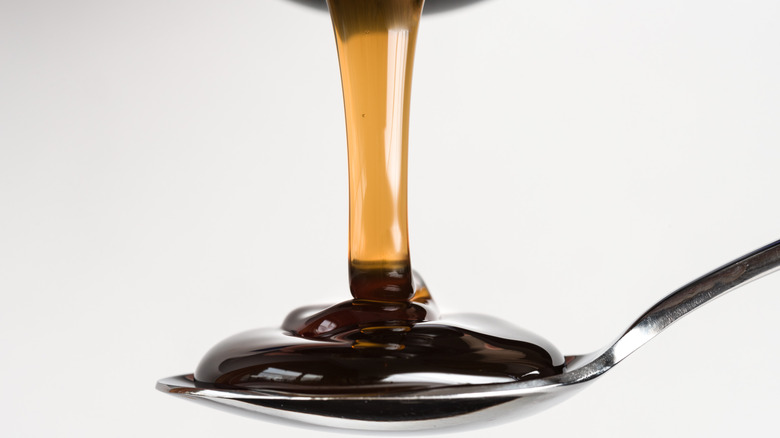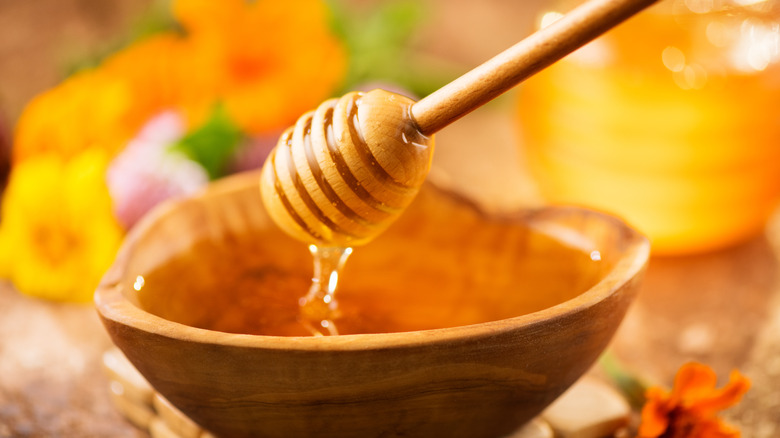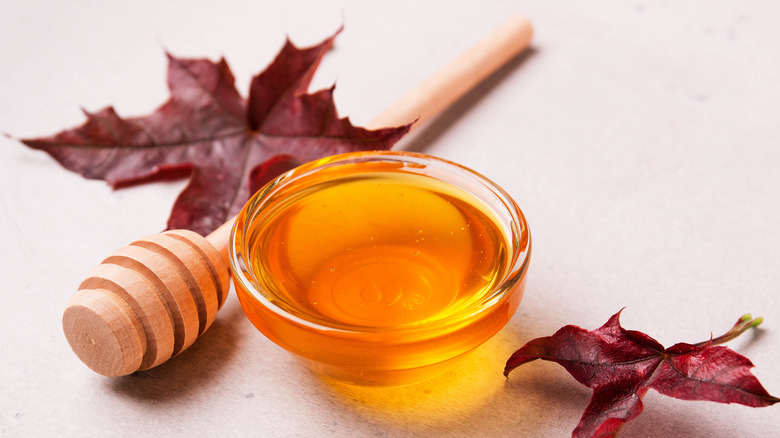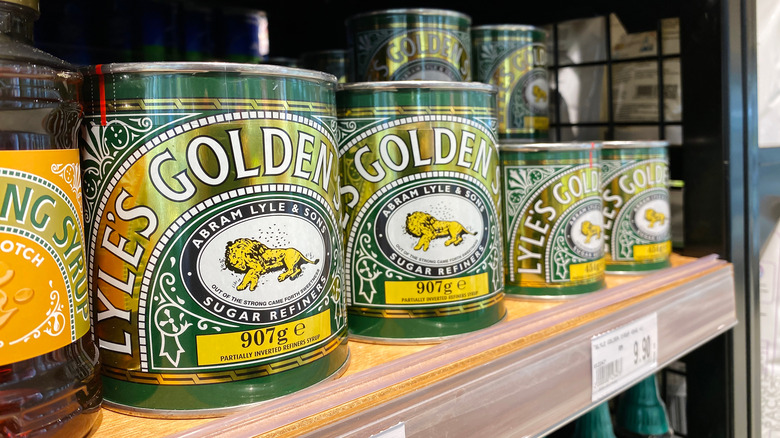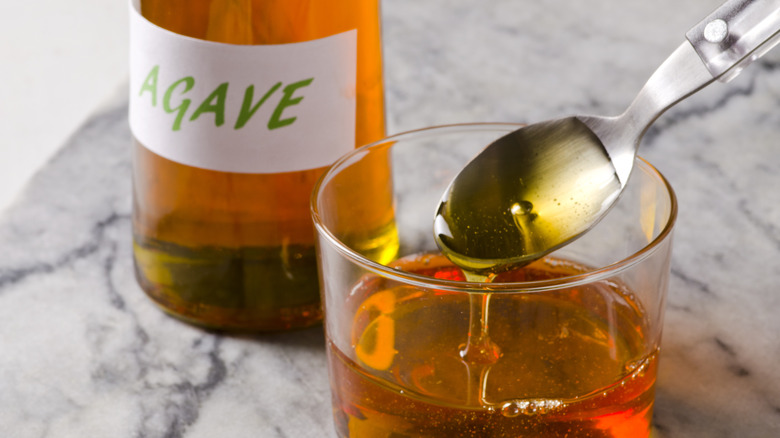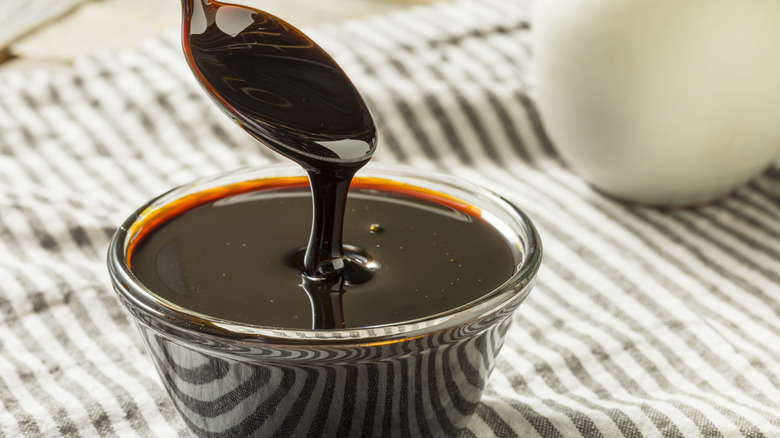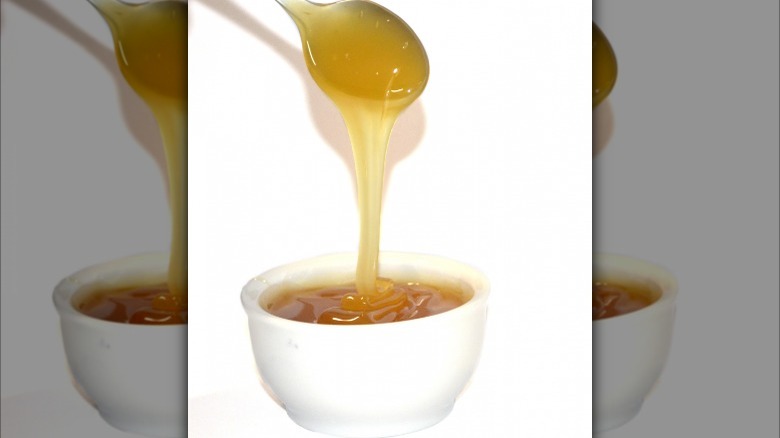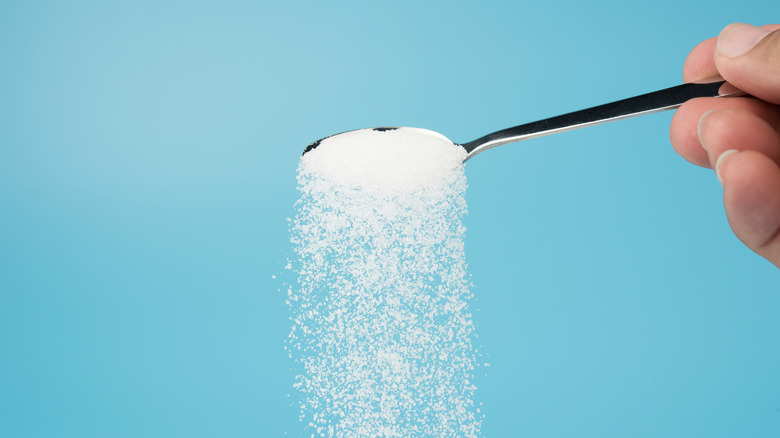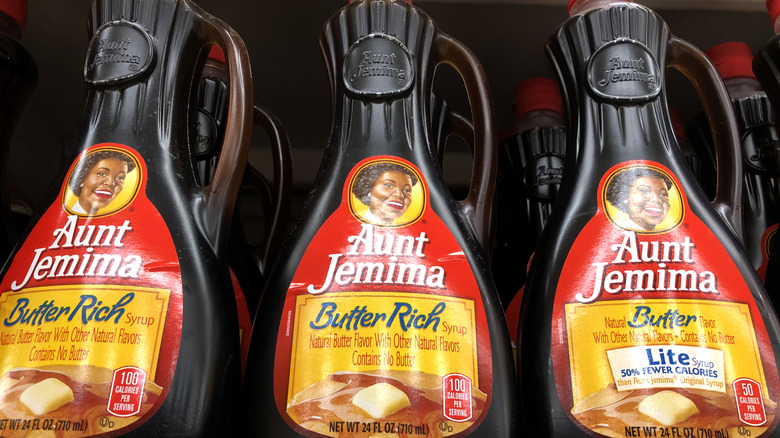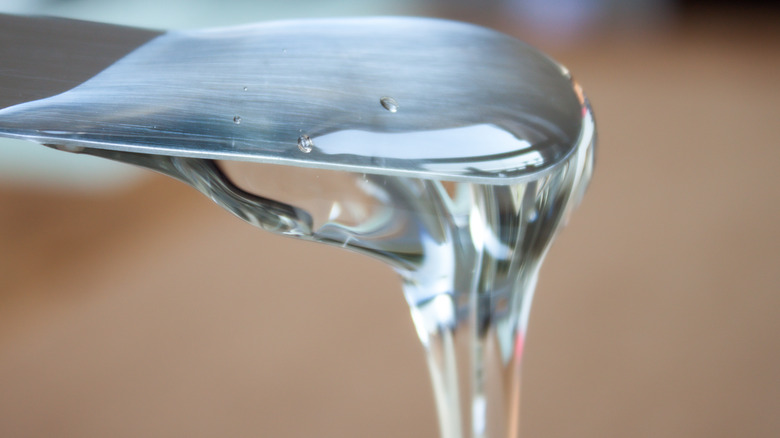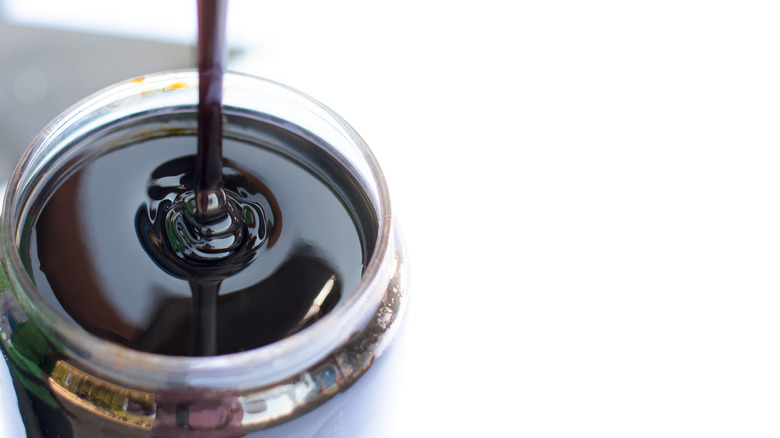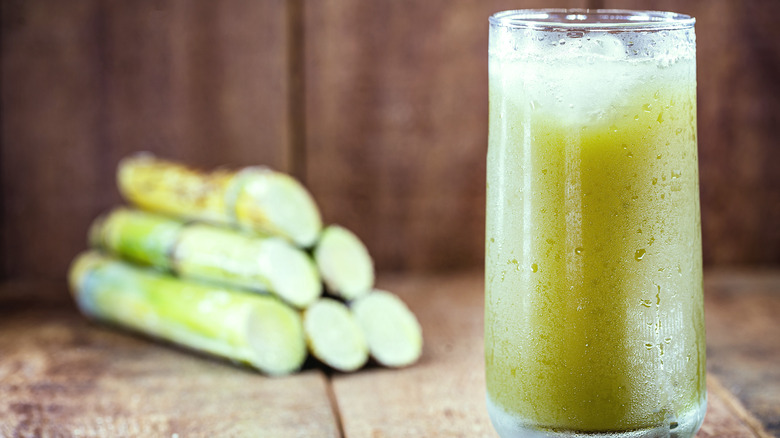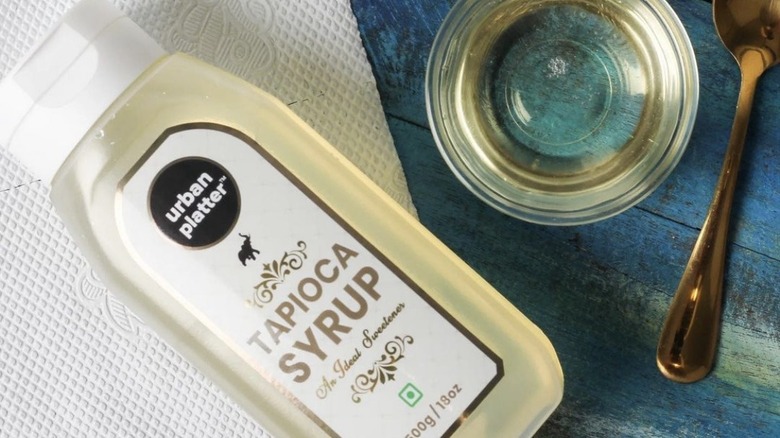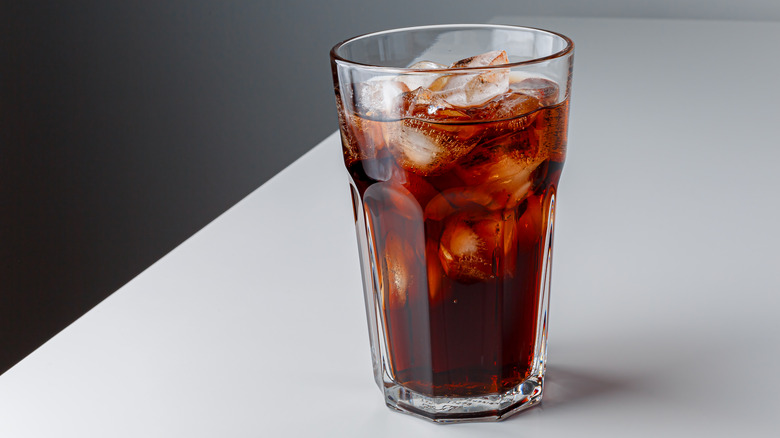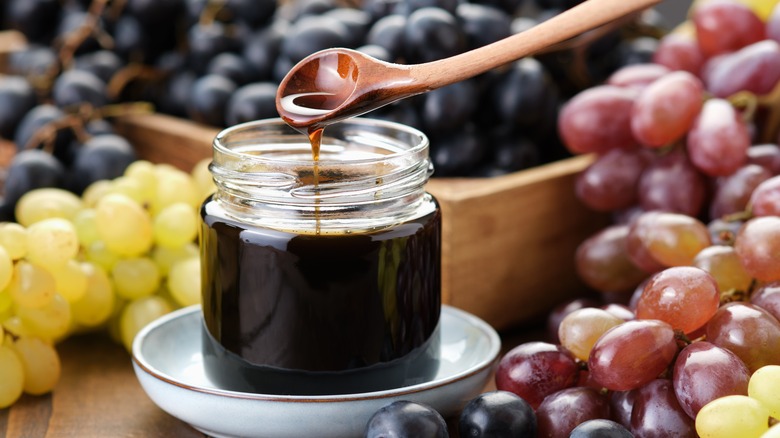The 14 Absolute Best Corn Syrup Substitutes
There might not be a more integral ingredient in everyday snack foods than corn syrup. Corn syrup is sold in bottles in the baking aisle of most grocery stores. It is made from a sugar called glucose extracted from corn. High fructose corn syrup (HCFS) takes the chemical processing of corn syrup to the next level. It transforms the glucose into fructose, which is sweeter and less satiating than most commercial sweeteners (via Cooking Light).
You're unlikely to see HCFS on a grocery store shelf (unless that shelf includes a case of Mountain Dew), but you will see two other kinds of corn syrup. According to Masterclass, light corn syrup is transparent in color and has a milder flavor than dark corn syrup, which is made with molasses.
These types of corn syrup are used for various dishes, including pecan pie and popcorn balls. But is it the end of the world if you can't find corn syrup for the one recipe you make a year that needs it? There are some simple substitutions you can make for corn syrup when you're in a pinch.
1. Honey
Honey has slightly more viscosity than corn syrup but is just as sweet. Clover honey, for example, has a high glucose content similar to corn syrup's glucose concentration. Therefore, most recipes can use a 1-to-1 substitute of honey for light corn syrup.
According to the Country Bee Honey Farm, there are some precautions you need to take when baking with honey that you may not follow for baking with corn syrup. Since honey is more acidic than corn syrup, you may need to supplement with some baking soda to help promote a proper rise in the batter. Honey should not be your go-to substitute for corn syrup for making candies or caramel because it may crystalize with heat.
This will impart a grainy texture to the sweet, which is not desirable in candy-making. Instead, use honey instead of corn syrup for baked goods, jams, and jellies. You likely won't be able to tell the difference between the two.
2. Maple syrup
If you're looking for a corn syrup substitute with slightly less viscosity and an organic flavor than honey, maple syrup should be your go-to. Maple syrup is thinner than corn syrup and imparts a more robust flavor. You can use a darker grade of maple syrup if you're looking for a more prominent maple flavor in your pie or quick bread, or stick to a lighter grade maple syrup for a less rich flavor.
Like honey, maple syrup can crystalize, so it should not be used as a replacement for corn syrup in caramel or candy. But you can use maple syrup as a 1-to-1 replacement for corn syrup in baked goods, spreads, and jams.
Maple syrup has numerous positive health benefits (as per Treejuice Maple Syrup). Pure maple syrup is high in antioxidants and micronutrients like calcium, potassium, B vitamins, zinc, and magnesium. Maple syrup can also enhance the flavors of certain ingredients like walnuts, pecans, and apples.
3. Golden syrup
Golden syrup, or golden treacle, is an ideal flavor and textural replacement for light corn syrup. To make golden syrup, manufacturers boil down sugar cane juice and crystalize the sugars until a thick, sweet syrup forms. Golden syrup is less sweet than table sugar because it contains more water (via Cooks Info).
It is likely harder to find golden syrup in America than it is corn syrup; Martha Stewart notes you can make some semblance of golden syrup at home by combining two parts light corn syrup with one part molasses. Instead, golden syrup is more commonly found in British pantries and used for classic British desserts like brandy snap biscuits, tarts, and toffee (via Martha Stewart).
If you can find golden treacle, you can use it as a substitution for corn syrup (with some precautions). According to Sweet Mouth Joy, golden syrup is slightly thicker than corn syrup with a slightly darker color. Therefore, the golden syrup might alter the color of your baked goods.
The flavor also might be different since corn syrup has a slight vanilla flavor, and golden syrup has a buttery aroma and caramel undertone. You can use golden syrup to elevate the flavor of many recipes where corn syrup is a classic ingredient, such as homemade pecan pie. You'll get the same sticky texture of the corn syrup with a more pleasant buttery flavor.
4. Agave syrup
Agave syrup is derived from the South American agave plant, which is also used to make tequila. You can purchase various grades of agave syrups, including light, amber, and dark. Light agave has a delicate, nuanced flavor, while darker syrups have a strong caramel flavor similar to golden syrup. Agave syrup is readily available in most major grocery stores.
According to Taste, agave is a sweeter, less viscous sweetener than honey. Agave is about 40 percent sweeter than table sugar and can be replaced with equal parts honey or maple syrup for a similar viscosity.
Agave syrup is a suitable replacement for maple syrup in recipes where the taste of the maple would conflict with other ingredients. You can use agave syrup as a 1-to-1 substitute for corn syrup in recipes outside of candy making. Its minimal viscosity may not do much as a binder, but it is a very effective sweetener.
5. Molasses
There's no molasses cookie without this crucial ingredient. There are three different types of molasses which are all byproducts of boiling sugar cane. The light molasses, or Barbados molasses, is the sweetest variation. It retains the most sugar from the sugarcane, so it would be the ideal replacement for light corn syrup. Dark molasses is boiled more than light molasses, so it has a less sweet and more complex flavor.
You'll want to use dark molasses to replace dark corn syrup. According to LeafTV, dark corn syrup doesn't activate the leavening reactions in some baked goods like molasses would, so you may have to play with the ratios of ingredients like cream of tartar or baking soda to get the desired rise. Use a 1-to-1 ratio for these respective substitutions. Unlike other substitutes for corn syrup, the chemical nature of molasses prohibits crystallization. As a result, you can use molasses in candy-making, just as you would corn syrup (via Reddit).
The last type, blackstrap molasses, does not have the sweet qualities as the two other varieties. Therefore, it should be exclusively used for savory food and is not a suitable flavor replacement for corn syrup.
6. Brown rice syrup
According to Sweet Additions, brown rice syrup is a gluten-free sweetener made by cooking down rice with enzymes which then transform the starches in the rice into sugars. The sugars produced are maltose, glucose, and maltotriose.
Brown rice syrup has a lower concentration of glucose than corn syrup (as well as an absence of fructose), meaning that it is less sweet than other substitutes for corn syrup. You'll find brown rice syrup listed in an array of foods, including chewy granola bars and breakfast cereals.
Sweet Additions shares that you can use a 1-to-1 substitution ratio for corn syrup and brown rice syrup. You won't get the same nutty taste as corn syrup, but you can use brown rice syrup as a replacement in hardball candy-making and high-heat cooking, which not many other substitutes can do. Brown rice syrup is also considered a lower-calorie substitute for corn syrup because it contains lower glucose levels.
7. Sugar and water
A mixture of granulated sugar and water is often called a "simple syrup." Most simple syrup recipes will use equal parts water and sugar for a thin, sweet consistency used to mix cocktails, drizzle on cakes, or mix into coffee. If you mix enough sugar with water, you've found one of the cheapest and easiest ways to substitute for light corn syrup.
You can use a mixture of four parts sugar to one part water to substitute corn syrup. This swap is best for making soft-ball candies like praline and fudge and will maintain a similar flavor to corn syrup.
You should avoid heating it past the soft-ball stage (235 degrees Fahrenheit), or else you'll notice the sugar starting to crystallize (via Exploratorium). It is difficult to replicate the color and taste of dark corn syrup with this substitute, so stick to using simple syrup for light corn syrup only.
8. Pancake syrup
What can't Aunt Jemima do? According to Greatist, corn syrup is one of the key ingredients inside "fake" maple syrup, otherwise known as "pancake syrup." The ingredient gives the spread its gooey, maple-syrup-like viscosity with a customizable taste that can be suited for individuals who like a fruity syrup or a butter-rich syrup for their morning stack of pancakes.
And while you may be vehemently opposed to eating anything that comes into contact with "fake maple," pancake syrup makes an excellent substitute for recipes where you don't have corn syrup handy. If you use this hack, you're going to want to start with the blandest flavor of syrup you can find.
For some recipes, like pies, you may get away with the "butter-lovers" variety (or a similar namesake), but for the most part, stick to the basic pancake syrup. Use equal parts pancake syrup for corn syrup in your recipe.
9. Glucose syrup
The relationship between glucose syrup and corn syrup is kind of like a "square and a rectangle" argument. Corn syrup is a glucose syrup, but not all glucose syrup is made of corn. Instead, most commercially available liquid glucose is derived from either wheat or corn, but other plants high in glucose include grapes, cranberries, or apricots (via Livestrong). Like different syrups, the starch is broken down with enzymes to concentrate a glucose-rich syrup. You'll find glucose syrup in many food and medical products like cough drops, jam, or ice cream.
Livestrong notes that glucose syrup is rarely used as a stand-alone sweetener in foods. However, its chemical and physical qualities allow glucose syrup to hold moisture in baked goods, add a shine to meringues, and prevent ice creams from crystallizing. In addition, LeafTV notes that since corn syrup is considered glucose syrup, you can substitute the two interchangeably without significantly damaging the quality and texture of whatever food you're making.
10. Dark treacle
Dark treacle has some similar qualities to light treacle. The product, also often found in the United Kingdom, has strong undertones of molasses. Although dark corn syrup shares some of the same molasses flavor as dark treacle, the latter is more intense. Dark treacle is much darker in color than dark corn syrup, which may make your baked goods too dark and thus prevent you from being able to tell when your baked goods are done (via Spiceography).
Dark corn syrup is slightly sweeter and has a little bit less prominent caramel flavor than dark treacle, but both have similar viscosities. Therefore, you can substitute treacle into a recipe for corn syrup in a pinch. There are some recipes where treacle will outperform corn syrup, and it likely wouldn't surprise you that these are British recipes like treacle tart or treacle pudding. The sweetness and complexity of the caramel flavor carry the other sweet notes in the dish and make these British desserts extraordinary.
11. Cane syrup
Cane syrup isn't just sugar in water. According to Livestrong, cane sugar is manufactured by simmering juice from the sugar cane in open kettles until it forms a sweet, molasses-like syrup. While cane syrup has a similar texture to molasses, it doesn't have the same sulfuric qualities as molasses. You'll often find cane syrup used as a table sweetener in the South, similar to granulated sugar at a diner.
You can use equal parts cane syrup to replace dark corn syrup in a recipe. In fact, many food manufacturers have started replacing cane sugar with corn syrup in their products because of how much cheaper it is to produce corn syrup. Some argue that the two taste different, but the consensus is that the two are interchangeable.
You'll get the same molasse-y notes as the dark corn syrup with similar physical viscosity. The best uses for this substitution include homemade marinades or barbecue sauces. It would be best to avoid candy-making because the cane syrup will crystalize at high temperatures (via America's Restaurant).
12. Tapioca syrup
Tapioca syrup is made by grinding the cassava root, a tuber endemic to the continents of South America and Africa, into a refined starch. Then, it is mixed with enzymes to convert the starches into sugars. It is gluten-free, and it can be used in both sweet and savory recipes (via Healthline). Besides being a sweetener, tapioca binds ingredients together and can smooth out other flavors in food.
According to Nutritional Outlook, tapioca syrup has the potential to be substituted for corn syrup in most recipes. The website notes that it can replace corn syrup using a 1-to-1 ratio. Like other alternative sweeteners, there are several different types of tapioca syrup ranging in color and quality.
Sweeter tapioca syrup, with a higher dextrose (DE) equivalent, has poor binding properties. In contrast, low-DE tapioca syrup is more viscous and can help granola bars stick together but may need a boost of sweetness from other added sweeteners if used in baking.
13. Cola
Do you know what's lurking behind that cola label? It's an unexpected ingredient that will elevate your pecan pie. Cola is essentially made from corn syrup mixed with carbonated water. If you cook off the water, you are left with a sticky, caramel-flavored syrup that can replace corn syrup in some (but not all) dishes.
Flair's Project notes that you'll need four liters of Coca-Cola and one-fourth cup of granulated sugar to make your own cola syrup. The website states that you should aim for Mexican coke, made from cane sugar, rather than the American version, which is made with corn syrup. This is because cane sugar is slightly sweeter than corn syrup. The additional granulated sugar adds a more robust flavor and aids in caramelization, but it can be omitted if needed.
Once the coke and the sugar are mixed, the ingredients are added to a saucepan and heated until boiling. Then, the concoction is simmered for another 20 minutes until the mixture thickens into a viscous paste. Flair's Project notes that you can continue to cook the mixture down if you want a reduction for glazing fruits or ice cream.
14. Grape molasses
You likely have never heard of grape molasses, let alone seen it in a store. The syrup is made by simmering down grape juice (or "grape must"). It is used in many traditional Greek recipes, including cookies, cakes, and pies (via Real Greek Recipes). The syrup can be simmered down to a syrup (grape molasses) or even more into a honey-like substance called petimezi.
The Persian Basket notes that grape molasses can be used as a 1-to-1 replacement for syrups and honey in recipes that need a little bit of a grape flavor. The website also recommends pouring the thick, molasses-like syrup on pancakes or yogurt parfaits.
The main downside of using this molasses replacement for corn syrup is that it has an entirely different flavor than the caramel notes of corn syrup. Therefore, you should reserve grape syrup for recipes with similar fruity flavors, such as apricots, berries, or apples.
